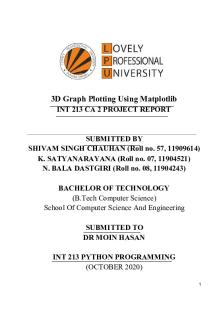Chapter 7 - 7.12 More Plotting PDF

| Title | Chapter 7 - 7.12 More Plotting |
|---|---|
| Author | Kyle Frudakis |
| Course | Python Programming |
| Institution | Florida Atlantic University |
| Pages | 2 |
| File Size | 120.4 KB |
| File Type | |
| Total Downloads | 2 |
| Total Views | 140 |
Summary
Learn how to plot in different ways
how to plot data more specifically...
Description
Chapter 7 - 7.12 More Plotting Wednesday, June 16, 2021
2:45 PM
Pylab Arrays • an important component of the pylab module is another Python module called numpy ○ short for "numeric python" ○ provides the following capabilities 1. a new data type, the array object 2. support for floating-point data types to interacting with arrays 3. support functions for floating-point values interacting with arrays • The array datatype ant its associated methods and functions is particularly useful • Pylab works with arrays, not lists ○ if you provide a list as an argument, pylab converts it to an array • Arrays are similar to lists ○ sequence data structure ○ mutable ○ responds to index assignments • Arrays can only hold one data type ○ default is floating-point number • we can use the array constructor ○ can turn a list to an array ○ list must consist of only numbers ▪ if there are ints, they will be turned to floats • arange does the same thing as range ○ values are floating-point instead of integers ○ takes 3 arguments 1. begin value (float) 2. end value (float) 3. increment (float) • An alternative to arange is the pylab method linspace ○ In arange, you specify how far apart you want the values ○ in linspace, you specify how many values you want
•
• There are a lot of overloaded operators for arrays ○ when you multiple an array by a floating number, then every element of the array will be multiplicated by that number >>> new_array = pylab.arange(0,2,0.1) >>> new_array array([0. , 0.1, 0.2, 0.3, 0.4, 0.5, 0.6, 0.7, 0.8, 0.9, 1. , 1.1, 1.2, 1.3, 1.4, 1.5, 1.6, 1.7, 1.8, 1.9]) >>> new_array * 0.5 array([0. , 0.05, 0.1 , 0.15, 0.2 , 0.25, 0.3 , 0.35, 0.4 , 0.45, 0.5 ,
0.55, 0.6 , 0.65, 0.7 , 0.75, 0.8 , 0.85, 0.9 , 0.95])
>>> Plotting Trigonometric Functions • knowing about arrays makes it a lot easier to create graphs...
Similar Free PDFs

Chapter 7 - 7.12 More Plotting
- 2 Pages

Chapter 23 problem more
- 2 Pages

3D Graph Plotting Using Matplotlib
- 13 Pages

712 LHM-2018 ene-mar - revista
- 52 Pages

300-Article Text-712-1-10-20210802
- 13 Pages

Chapter 7 quiz#7
- 3 Pages

Assignment #7 Chapter 7
- 2 Pages

Chapter-7
- 7 Pages

Chapter 7
- 4 Pages

Chapter 7
- 57 Pages

Chapter 7
- 46 Pages
Popular Institutions
- Tinajero National High School - Annex
- Politeknik Caltex Riau
- Yokohama City University
- SGT University
- University of Al-Qadisiyah
- Divine Word College of Vigan
- Techniek College Rotterdam
- Universidade de Santiago
- Universiti Teknologi MARA Cawangan Johor Kampus Pasir Gudang
- Poltekkes Kemenkes Yogyakarta
- Baguio City National High School
- Colegio san marcos
- preparatoria uno
- Centro de Bachillerato Tecnológico Industrial y de Servicios No. 107
- Dalian Maritime University
- Quang Trung Secondary School
- Colegio Tecnológico en Informática
- Corporación Regional de Educación Superior
- Grupo CEDVA
- Dar Al Uloom University
- Centro de Estudios Preuniversitarios de la Universidad Nacional de Ingeniería
- 上智大学
- Aakash International School, Nuna Majara
- San Felipe Neri Catholic School
- Kang Chiao International School - New Taipei City
- Misamis Occidental National High School
- Institución Educativa Escuela Normal Juan Ladrilleros
- Kolehiyo ng Pantukan
- Batanes State College
- Instituto Continental
- Sekolah Menengah Kejuruan Kesehatan Kaltara (Tarakan)
- Colegio de La Inmaculada Concepcion - Cebu




